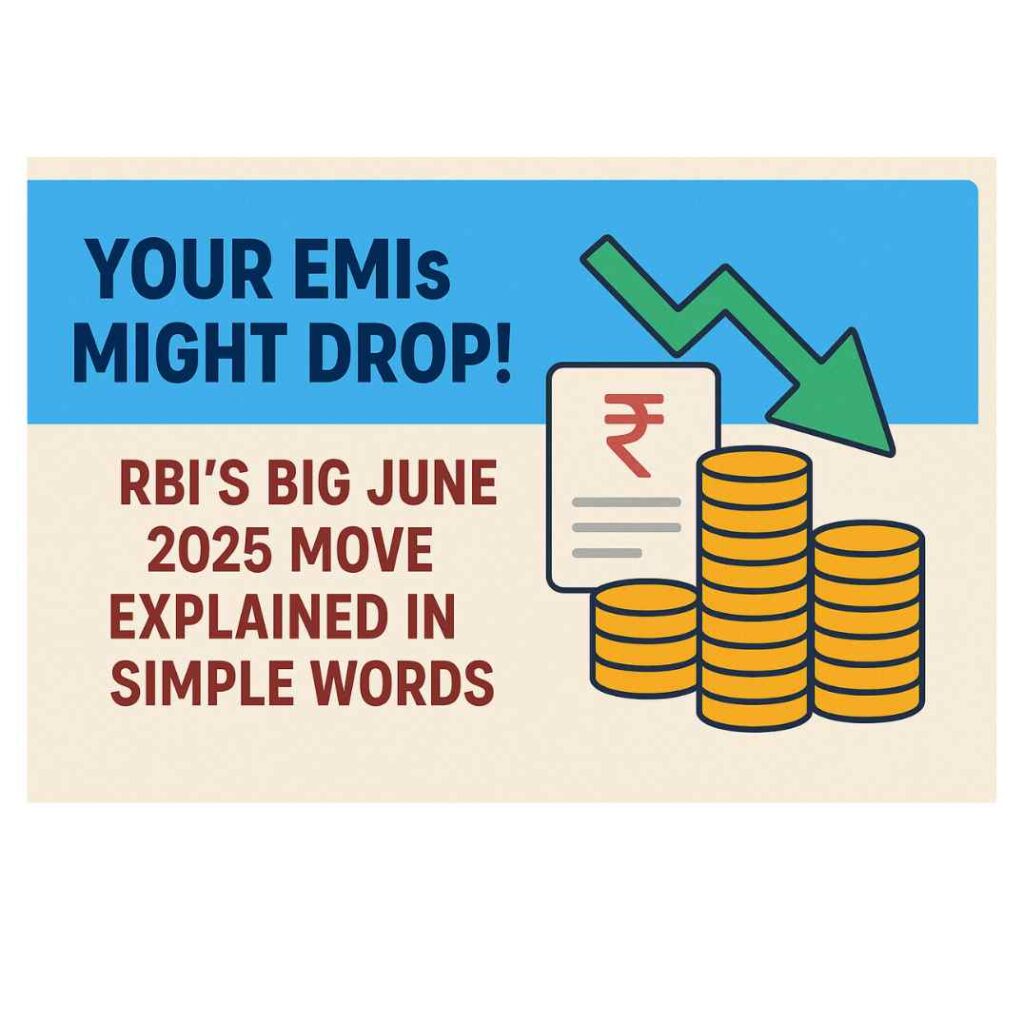What is Repo Rate?
Repo rate is the interest rate at which the Reserve Bank of India (RBI) lends money to commercial banks. If banks need money, they borrow it from RBI and pay interest. That interest rate is called the repo rate.
Why Does the Repo Rate Matter?
Repo rate decides how expensive or cheap it is for banks to borrow money. If the repo rate is high, banks have to pay more to get money. So, they also charge higher interest when giving loans to people. If the repo rate is low, banks borrow cheaply and give loans at lower rates. It affects everything from home loans, car loans, business loans to EMIs.
What Happened in June 2025?
In June 2025, the Reserve Bank of India reduced the repo rate by 0.25%. Earlier, the repo rate was 6.5%. Now it is 6.25%. This is called a repo rate cut. It means loans and EMIs might get cheaper soon.
Why Did RBI Cut the Repo Rate?

There are three main reasons:
1. Slow Economic Growth
India’s economy was not growing fast. Businesses were not expanding much. People were not spending as much money. So, RBI wanted to make borrowing cheaper to push spending and investment.
2. Controlled Inflation
Inflation means the rise in prices. If inflation is too high, RBI cannot cut the repo rate. But in mid-2025, inflation was under control. The prices of daily items like food and fuel were stable. So RBI got room to reduce the repo rate.
3. Global Trends
Many countries were also cutting interest rates. The U.S., Europe, and other Asian countries were doing the same to support their economies. So, RBI also followed the global trend.
How Does It Affect You?
1. Lower EMIs
If you have a home loan, car loan, or personal loan, your EMI (monthly payment) may reduce. But it depends on your bank and the type of loan you have. Most floating-rate loans will see a drop in EMIs.
2. Cheaper New Loans
If you plan to take a new loan, the interest rate may be lower. You might pay less overall for your loan.
3. Good Time to Buy Big Items
Because loans may get cheaper, it can be a good time to buy a home, car, or start a business. Banks may offer better loan deals.
4. Impact on Fixed Deposits (FDs)
While loans get cheaper, returns on FDs may go down. Banks may reduce FD interest rates. So, people who depend on FD income may earn a bit less.
Impact on Businesses
Businesses can benefit a lot. They can take loans at lower rates to grow their company. New factories, shops, or services can come up. Lower loan rates mean more investments and more jobs.
Small businesses and startups may find it easier to get working capital. This helps the economy grow.
Impact on Stock Market
Usually, a repo rate cut is good for the stock market. It means companies may earn more profits as loans become cheaper. Investors often feel positive, and stock prices may go up.
What Should You Do Now?
1. Check Your Loan Type
If you have a loan, see if it is a fixed-rate or floating-rate loan. Floating-rate loans will get cheaper. Talk to your bank about how much your EMI may change.
2. Refinance High-Interest Loans
If you took a loan earlier at a higher rate, you can think of transferring it to a bank offering lower rates. This is called refinancing. It can reduce your monthly payments.
3. Review Your FD Plans
If you are investing in FDs, keep an eye on interest rates. Try locking FDs at higher rates if you find good offers now. Later, FD rates may fall.
4. Think Long-Term
Rate cuts are part of a cycle. Over time, they may go up again. Plan your loans and investments keeping this in mind. Don’t rush into big decisions without understanding your budget.
Common Misunderstandings
1. “EMIs will reduce immediately.”
Not always. Some banks take time to pass on the benefit. Talk to your bank. It may take 1-2 months to see the change.
2. “All types of loans will get cheaper.”
Only floating-rate loans will get cheaper right away. Fixed-rate loans will stay the same.
3. “Repo rate cut means more money in everyone’s hands.”
It helps many people, but not all. People who depend on FDs may earn less. So, it is a mixed effect.
RBI’s Goal
The RBI wants to balance two things: low inflation and strong growth. By cutting the repo rate in June 2025, the RBI is hoping to:
- Encourage people to borrow and spend.
- Help businesses grow.
- Support overall economic development.
But RBI also watches inflation. If prices start rising too much, they may raise the repo rate again. So, it is a careful balancing act.
Final Thoughts
The repo rate cut in June 2025 is a step to boost the Indian economy. For common people, it may bring lower EMIs and cheaper loans. But it can also lower FD returns. It is important to understand how it affects you and plan your money wisely.
In simple terms, RBI is trying to give a gentle push to the economy. If all goes well, it could lead to more jobs, better business, and more spending. Let us hope the move helps India grow stronger and faster.

















What do you think?
It is nice to know your opinion. Leave a comment.